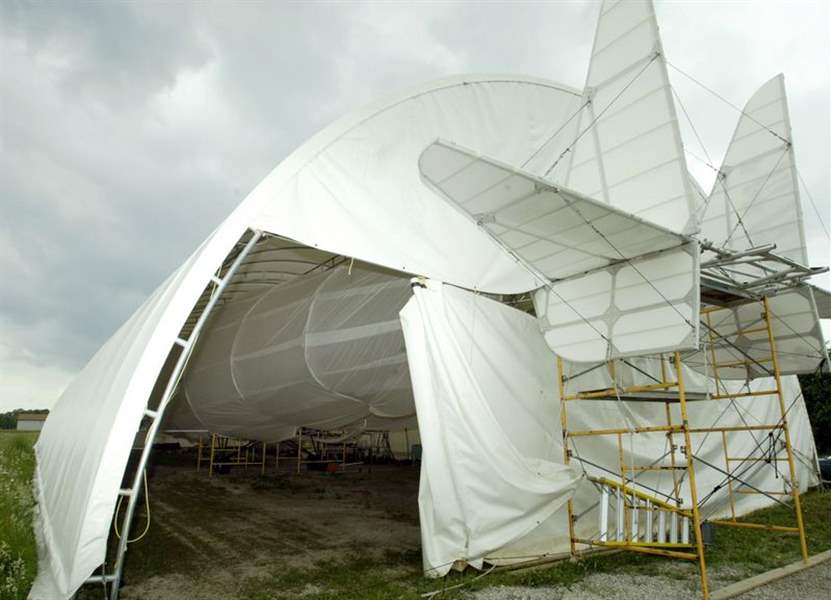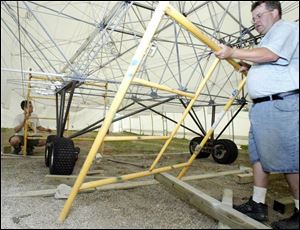
Reaching for an airship revival
6/19/2005
The tail of the prototype Dynalifter juts out from a canvas hangar on an airstrip in Stark County.
Scott R. Galvin / AP

The tail of the prototype Dynalifter juts out from a canvas hangar on an airstrip in Stark County.
ALLIANCE, Ohio - Sometimes, the brightest innovations come from the most unlikely of places.
When Steve Wozniak and Steve Jobs launched their Apple personal computer in 1977, no one imagined a computer revolution would begin in Mr. Wozniak's garage.
Similarly, if Robert Rist and Brian Martin one day achieve such fame, they can trace their idea to change the transportation industry by reviving airships back to the outskirts of this Stark County town and a canvas quonset-like hangar at a tiny grass airfield.
Inside their gravel-floor workshop at Barber Airport, the headquarters for their tiny Ohio Airships Inc., the two men are close to finishing a 119-foot-long prototype airship they call a Dynalifter.
They believe its unique design - half-dirigible, half-plane - will make it the backbone of a global low-cost transport system that can reach areas where roads don't exist, ships can't reach, and other methods of hauling goods are hideously expensive.
"The Dynalifters aren't going to compete with the trucking industry. But we like to think of it as roadless trucking," said Mr. Martin, 32, a former computer database programmer who lives in Alliance.
They envision the Dynalifter as having unlimited commercial, industrial, and military applications, if it can get aloft and prove its viability.
That test won't occur until at least August, when they plan to circle the airship around Barber Airport. But Mr. Martin and Mr. Rist, 44, who grew up in Pemberville but now lives in Mantua, Ohio, are almost giddy at the progress their pipe dream has achieved since 1999.
That's when the men, staff workers at nearby Mount Union College, hatched their plan.
Mr. Rist came up with the idea while building a model airship for his son and pitched the idea to Mr. Martin. "The best business decision I ever made was not to laugh on the spot at his idea," Mr. Martin said.
Now nearly 80 percent complete and using about 100 people to help build it, their 2,200-pound prototype Dynalifter Patroller will end up costing about $500,000 to develop and build.
It is the first of a fleet of four planned sizes of airships. Computer simulations and wind-tunnel tests at Ohio State University have shown they should fly successfully.
What makes the design unique is that, like a blimp, the craft uses helium to achieve 50 percent of its lift. The remaining lift will be from four wings and propellers.
Inside the pickle-shaped prototype, which Mr. Rist unofficially dubbed the Walrus, is an aluminum spine running its length and two patented towerlike structures that support the spine, wings, gas-powered engines, cockpit, and landing gear, and provide the craft with additional strength and stability.
Helium will be stored in four bags that use a third of the craft's interior. A two-person cockpit, which is the payload, is attached to the bottom. Larger Dynalifters will have interior holds for cargo containers.
But it is neither blimp nor dirigible. A blimp is a non-rigid gasbag with engines and a gondola attached. A dirigible has a rigid frame and skin. It carries gasbags inside it to provide lift.
The Dynalifter has a rigid shape and gasbags but will achieve lift like an ultralight craft or a Piper Cub airplane, and can take off and land in short distances - 4,000 feet - without ground crews used by blimps and dirigibles.

Bob Rist, foreground, and Brian Martin remove the scaffolding that had supported the Dynalifter before the wheel assembly was attached.
The prototype is designed to lift just two people, but a planned 990-foot heavy-freighter could carry 160 tons of payload and travel at 100 miles per hour. A Boeing 747 cargo ship can haul 124 tons and travel about 565 mph.
If the prototype proves feasible, copies could be built by an aircraft manufacturer for about $100,000 in less than a year, the two men said. One manufacturer told them their largest 990-foot model would cost $100 million.
Whether the project is feasible is debatable.
John Sullivan, a professor of aeronautics at Purdue University, is familiar with the Dynalifter concept and calls it promising. For the last year, he has done research on high-altitude airships for the U.S. Air Force.
"Does [the Dynalifter] make sense? At this stage I think it needs some more study," he said. "With new materials and techniques now available, there is a real case for developing this.
"For certain missions, their concept can make sense."
But Mark Ardema, a mechanical engineering professor at the University of Santa Clara in California, said, "Frankly, hybrids are not a good idea.
"They are attempts to combine the worst aspects of airships and airplanes. What you get is all the low speed of airships and inefficiencies of loaded structures like airplanes. We did a lot of studies on that in the '70s."
The professor, who led NASA's modern airship program from 1974 to 1980, said good ideas didn't get funded and bad ideas that garnered heavy investment. However, he said, the best role for an airship, whether hybrid or not, is as a heavy lifter, not long hauler.
That's because the airships are slow, and transportation is time driven, he explained.
But Mr. Rist and Mr. Martin said they do not plan to compete with cargo airplanes but would have an advantage in going to places that cannot accommodate large airplanes.
Barry Prentice, a professor of transportation at the University of Manitoba in Winnipeg, said a Dynalifter system would be ideal in Canada.
He organized an annual conference in Canada to promote an airship industry revival to open up Canada's northern territories to commerce.
"For airships, their time has come, is how I would put it," he said. Breakthroughs in lightweight materials, avionics, and hydraulics as well as sophisticated radar make it feasible to build advanced airships, he added.
Mr. Prentice said a large Dynalifter easily could land and take off in northern Canada. "You have a storehouse of base metals and gold and diamonds and oil in the north," he said. "The trouble is you can't get to it right now."
For now, the aerospace industry isn't taking the two men seriously. That means no one is trying to beat them to the marketplace, but it makes it harder to raise needed money to proceed.
So far, money has come from the two, their families and friends, and a few investors. The two say their business plan has allowed them to secure all the private cash needed to finish their prototype.
They have a business plan which calls for their prototype, if successful, to recoup its costs through flying advertisements. Several companies have said they are willing to pay to fly their name over sporting or other events, the men said.
That income could lead to franchising or development of the craft's intended purpose: a bigger airship to haul freight. Mr. Rist said the crafts could move between airport hubs and company warehouses.
Their concept might seem like science fiction to some, but the timing is good.
Mr. Prentice and others said there is a movement afoot to revive airships, for uses including security surveillance and cargo hauling.
The U.S. Defense Department has said it wants aerospace companies to make proposals to build airships that could transport a complete combat unit from its fort to the battlefield, and in another proposal it has said it would like to recruit supply chain and airship companies to help create a public-private manufacturing base, similar to that in the aircraft industry, and build commercial airships that the government could use when it needs them.
Until three years ago, it appeared that Germany would be the first to market a heavy-lifting semi-rigid airship. But the multimillion-dollar program hit financial difficulty and was halted in 2002.
The German craft, known as the CargoLifter, had a market, Mr. Martin said, and since the Sept. 11, 2001, terror attacks, the U.S. Department of Homeland Security and other state and local law enforcement agencies have expressed interest in affordable aircraft surveillance activities.
Airships have been identified as ideal because of low operating costs and the ability to stay aloft for long periods.
Neither Mr. Rist or Mr. Martin have aeronautical backgrounds. They hired Daniel Raymer, formerly of Lockheed Martin, to design their craft based on their sketches.
Said Mr. Prentice, of Winnipeg: "What needs to happen is for them to fly this thing and see how it's going to perform."
Contact Jon Chavez at: jchavez@theblade.com or 419-724-6128.